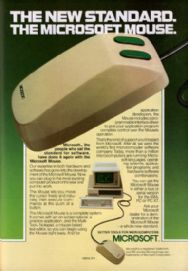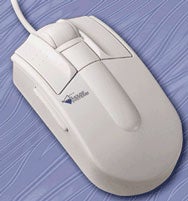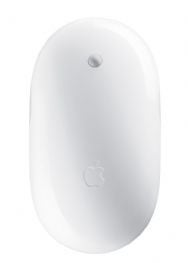The computer mouse turns 40 (original) (raw)
From the halls of a university research lab to the desks of hundreds of millions of computer users, the computer mouse has come a long way. Douglas Engelbart created the first prototypes of the now-familiar device in 1963 at Stanford Research Institute, but he first displayed his creation to the public in 1968 forty years ago Tuesday. During that unveiling, Engelbart presented what some have called “the mother of all demos,” outlining concepts that would presage the next 40 years of computing, including the use of a three-button palm-sized contraption called a “mouse.”
Since then, a handful of companies (namely Xerox, Apple, Microsoft, and Logitech) have poured millions into refining the form and function of the mouse: they’ve changed its number of buttons, changed the interfaces by which mice connect to computers, and tinkered with new methods of tracking movement. But despite four decades of commercial evolution, computer users today handle the mouse in much the same way Engelbart did 40 years ago: as an ingeniously efficient and easy-to-use pointing device.
With the coming of this anniversary, some pundits have been quick to forecast the looming demise of the mouse at the hands of touch screens and speech recognition. But as long as computers require hands-on input from humans, we’ll probably have a nook on our desks reserved for our small electronic friends. Forty years later, the mouse has become an indispensable tool for computer input, and its excellence at certain tasks means that it will likely be with us for some time to come. (Read senior editor Dan Frakes’ picks for the five best current input devices.)
Notable moments in mouse history
1963: Bill English constructs first mouse prototype based on Douglas Engelbart’s sketches. This mouse uses two perpendicular wheels attached to analog potentiometers to track movement. The first mouse has only one button, but more are to come.
1968: Douglas Engelbart gives a 90-minute demonstration on December 9 at the Fall Joint Computer Conference in San Francisco. Among other things, it showcases a refined SRI mouse with three buttons.
1972: Jack Hawley and Bill English, inspired by Engelbart’s work, design a digital mouse for Xerox PARC. This new mouse does not require an analog-to-digital converter but instead sends digital positional information directly to the computer. It also contains the first mouse ball, a metal ball bearing pressed against two rollers to track movement. A similar tracking design (albeit with a few drastic modifications), would be used in most mice for the next 27 years.
1981: Xerox produces a commercial mouse for its expensive 8010 Information System (aka the “Star”). It features two buttons and ball tracking. However, the entire Star system sells for over $20,000, dooming it and its mouse to relative obscurity.
Under contract, design firm Hovey-Kelley creates the first inexpensive, mass-producible, reliable mouse for Apple. Its key components include optical encoder wheels, a free-moving tracking ball, and a precision injection-molded inner frame. This design breakthrough sets the stage for cheap, reliable consumer mice that everyone can afford.
Richard Lyon invents the first optical mouse at Xerox PARC. This mouse requires a special dot-covered pad for tracking.

The Mouse House’s Hawley X063X Mouse.
1982: Steve Kirsch invents an optical mouse that requires a mousepad with a grid printed on it for tracking. He founds Mouse Systems in 1982 to sell the first commercial optical mouse and later provides precision mice for Sun workstations, among others.
Logitech sells its first mouse, the P4, designed by Jean-Daniel Nicoud. This dome-shaped device, among the first commercial mice available, sells for $299.
1983: With permission from Xerox, Jack Hawley founds Mouse House to refine and sell his original Xerox mouse design. The boxlike, three-button Hawley X063X uses brush contact encoder wheels and costs about $400.
Apple’s first commercial mouse goes public as part of the Apple Lisa system. The mouse uses a squeeze-release DE-9 connector and notably features only one button—a controversial design decision that would remain the hallmark of Apple mice for 22 years.
Microsoft ships its first IBM PC mouse, retailing for $195. The two-button mouse initially requires a special peripheral card for use but later supports connection through a PC’s serial port.

The original Microsoft Mouse.
1984: Apple ships a one-button mouse with the original Macintosh featuring a new exterior redesign. It features a nine pin DE-9 connector with thumb screws to secure the connector in place. Functionally, the mouse operates nearly identically to its Lisa predecessor.
Logitech designs the world’s first cordless mouse as part of the obscure Metaphor computer system. The battery-powered mouse uses infrared light (like a TV remote control) to communicate with a base receiver unit. Various companies try a similar IR technique over the years, but it never takes off.
1986: Apple introduces a new way of connecting mice and keyboards—Apple Desktop Bus (ADB)—with the launch of the Apple IIgs, and on the Mac SE a year later. Not surprisingly, Apple releases a new wedge-shaped mouse for the bus called the Apple Desktop Bus Mouse.
1987: IBM introduces the PS/2 line of PCs, which feature the world’s first PS/2 mouse connectors. These connectors later become a standard in the PC-clone world.
1991: Logitech releases the world’s first wireless mouse to use radio frequency (RF) transmission, the Cordless MouseMan. Unlike infrared (IR) cordless solutions, Logitech’s mouse does not require line-of-sight with a base station to work.
1993: Honeywell introduces a unique mouse tracking concept with its Opto-Mechanical mouse. Instead of a rolling ball, the mouse uses two small angled discs on its bottom that track movement.
Apple releases the Apple Desktop Bus Mouse II, which features a more ergonomic teardrop shape than its wedge-shaped predecessor. Otherwise, the mouse is functionally identical.

Mouse Systems’s ProAgio—the first commercial mouse with a scroll wheel.
1995: Mouse Systems releases ProAgio, the first commercial mouse with a scroll wheel. Few people notice.
1996: Microsoft popularizes the scroll wheel with the release of the IntelliMouse Explorer. It features a rubberized plastic wheel placed between two standard mouse buttons that can also be pressed as a button. Rotating the wheel allows easy scrolling of windows, among other functions.
1998: The Apple “hockey puck” mouse ships with the original iMac. Aside from its ergonomically questionable saucer-shaped appearance, this mouse (formally titled Apple USB Mouse) is notable as the first Apple mouse to support the USB peripheral standard. Simultaneously, the iMac marks the beginning of the end of the ADB interface that graced Macs for 11 years.
1999: Agilent develops the first optical mouse sensor that works without need for a special pad, providing a breakthrough for the optical tracking revolution. This LED-based sensor and its successors would later be used in mice from Microsoft, Logitech, Apple, and dozens of other companies.
Microsoft releases its first optical mice. The IntelliMouse Explorer with IntelliEye ($70) features no less than five buttons and an optical tracking sensor that doesn’t require a special mouse pad. Microsoft also offers a simpler optical mouse for a lower price.
Following Logitech’s recent improvements in RF cordless technology, Microsoft releases its first RF wireless mouse, the Cordless Wheel Mouse, marking the beginning of a new wireless trend. Other peripheral makers follow suit with a new generation of more accurate and battery-efficient wireless mice.
2000: Apple releases the Pro Mouse, its first mouse with an optical tracking sensor. It features a monolithic surface button and a stylish translucent oblong shape.

Apple’s Wireless Mighty Mouse.
2003: Apple releases its first wireless mouse, unsurprisingly titled the Apple Wireless Mouse. It uses Bluetooth as its wireless protocol, but it still has only one button.
2004: Logitech releases the first mouse to use a laser for optical tracking, the MX 1000. The laser tracking system, developed by Agilent, provides far greater accuracy than the previous LED-based optical tracking method.
2005: Apple releases the Mighty Mouse, its first mouse to feature more than one button (four, in fact). Ironically, the two main buttons are not physical, but instead use capacitive touch sensors with a tiny speaker to provide audible feedback for each click. The mouse also includes a scroll ball that lets users scroll in any direction.
2006: Apple releases the Wireless Mighty Mouse, which uses the Bluetooth wireless protocol.
2008: Logitech ships its one-billionth mouse since it began selling them in 1982.